HA3011 Advanced Financial Accounting: Case Study Analysis & IFRS
VerifiedAdded on 2023/06/11
|7
|1809
|65
Case Study
AI Summary
This case study solution provides an analysis of advanced financial accounting principles, focusing on IFRS compliance and the qualitative features of financial reporting. It addresses concerns raised by CFOs regarding the usefulness of IFRS for investors, explores government regulation theories related to financial reporting, discusses the implications of asset revaluation and impairment, and examines managerial incentives for not adopting fair value models. The analysis incorporates perspectives from industry professionals and academic research to provide a comprehensive understanding of the challenges and considerations in advanced financial accounting. The document concludes with recommendations for adhering to accounting standards to ensure accurate and transparent financial reporting.
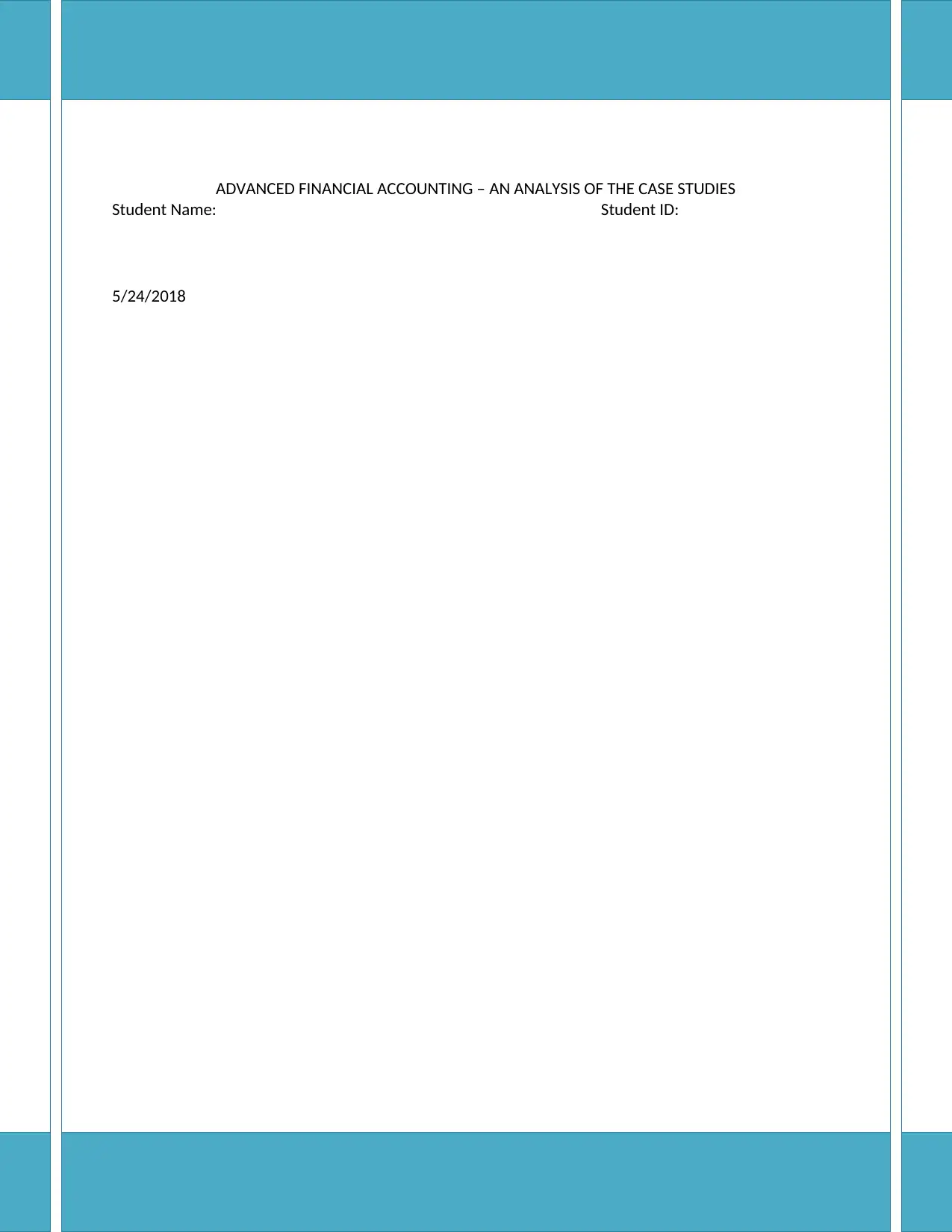
ADVANCED FINANCIAL ACCOUNTING – AN ANALYSIS OF THE CASE STUDIES
Student Name: Student ID:
5/24/2018
Student Name: Student ID:
5/24/2018
Paraphrase This Document
Need a fresh take? Get an instant paraphrase of this document with our AI Paraphraser
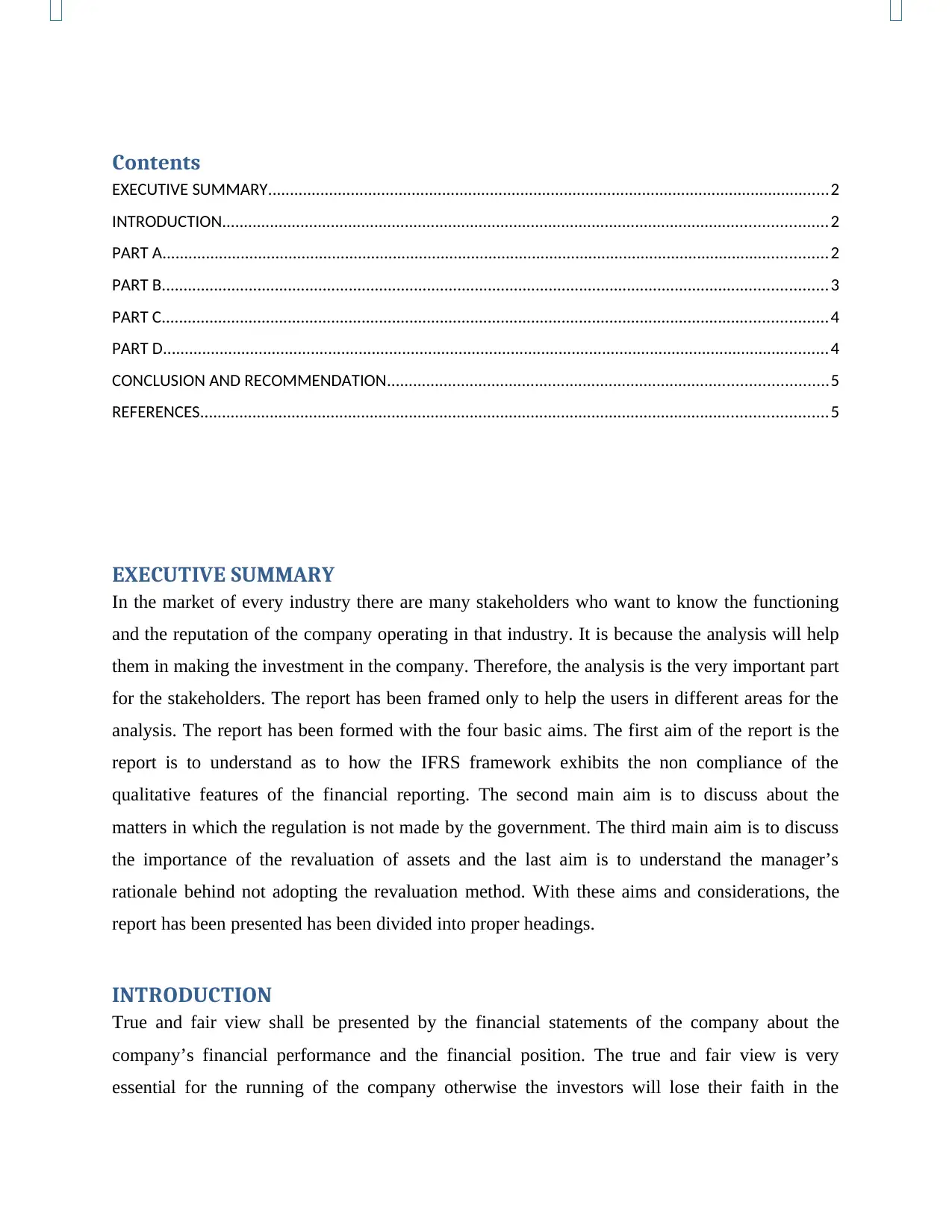
Contents
EXECUTIVE SUMMARY.................................................................................................................................2
INTRODUCTION...........................................................................................................................................2
PART A.........................................................................................................................................................2
PART B.........................................................................................................................................................3
PART C.........................................................................................................................................................4
PART D.........................................................................................................................................................4
CONCLUSION AND RECOMMENDATION.....................................................................................................5
REFERENCES................................................................................................................................................5
EXECUTIVE SUMMARY
In the market of every industry there are many stakeholders who want to know the functioning
and the reputation of the company operating in that industry. It is because the analysis will help
them in making the investment in the company. Therefore, the analysis is the very important part
for the stakeholders. The report has been framed only to help the users in different areas for the
analysis. The report has been formed with the four basic aims. The first aim of the report is the
report is to understand as to how the IFRS framework exhibits the non compliance of the
qualitative features of the financial reporting. The second main aim is to discuss about the
matters in which the regulation is not made by the government. The third main aim is to discuss
the importance of the revaluation of assets and the last aim is to understand the manager’s
rationale behind not adopting the revaluation method. With these aims and considerations, the
report has been presented has been divided into proper headings.
INTRODUCTION
True and fair view shall be presented by the financial statements of the company about the
company’s financial performance and the financial position. The true and fair view is very
essential for the running of the company otherwise the investors will lose their faith in the
EXECUTIVE SUMMARY.................................................................................................................................2
INTRODUCTION...........................................................................................................................................2
PART A.........................................................................................................................................................2
PART B.........................................................................................................................................................3
PART C.........................................................................................................................................................4
PART D.........................................................................................................................................................4
CONCLUSION AND RECOMMENDATION.....................................................................................................5
REFERENCES................................................................................................................................................5
EXECUTIVE SUMMARY
In the market of every industry there are many stakeholders who want to know the functioning
and the reputation of the company operating in that industry. It is because the analysis will help
them in making the investment in the company. Therefore, the analysis is the very important part
for the stakeholders. The report has been framed only to help the users in different areas for the
analysis. The report has been formed with the four basic aims. The first aim of the report is the
report is to understand as to how the IFRS framework exhibits the non compliance of the
qualitative features of the financial reporting. The second main aim is to discuss about the
matters in which the regulation is not made by the government. The third main aim is to discuss
the importance of the revaluation of assets and the last aim is to understand the manager’s
rationale behind not adopting the revaluation method. With these aims and considerations, the
report has been presented has been divided into proper headings.
INTRODUCTION
True and fair view shall be presented by the financial statements of the company about the
company’s financial performance and the financial position. The true and fair view is very
essential for the running of the company otherwise the investors will lose their faith in the
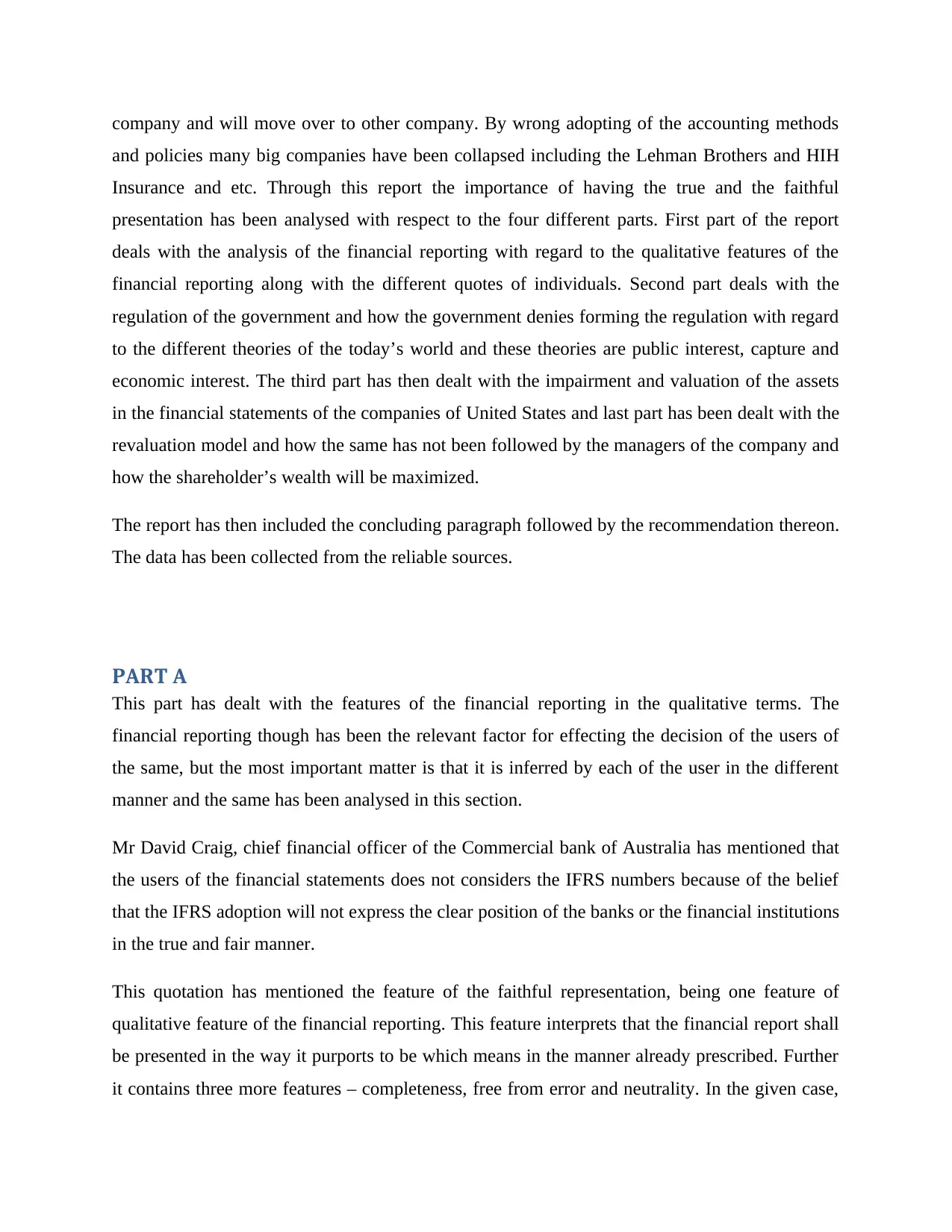
company and will move over to other company. By wrong adopting of the accounting methods
and policies many big companies have been collapsed including the Lehman Brothers and HIH
Insurance and etc. Through this report the importance of having the true and the faithful
presentation has been analysed with respect to the four different parts. First part of the report
deals with the analysis of the financial reporting with regard to the qualitative features of the
financial reporting along with the different quotes of individuals. Second part deals with the
regulation of the government and how the government denies forming the regulation with regard
to the different theories of the today’s world and these theories are public interest, capture and
economic interest. The third part has then dealt with the impairment and valuation of the assets
in the financial statements of the companies of United States and last part has been dealt with the
revaluation model and how the same has not been followed by the managers of the company and
how the shareholder’s wealth will be maximized.
The report has then included the concluding paragraph followed by the recommendation thereon.
The data has been collected from the reliable sources.
PART A
This part has dealt with the features of the financial reporting in the qualitative terms. The
financial reporting though has been the relevant factor for effecting the decision of the users of
the same, but the most important matter is that it is inferred by each of the user in the different
manner and the same has been analysed in this section.
Mr David Craig, chief financial officer of the Commercial bank of Australia has mentioned that
the users of the financial statements does not considers the IFRS numbers because of the belief
that the IFRS adoption will not express the clear position of the banks or the financial institutions
in the true and fair manner.
This quotation has mentioned the feature of the faithful representation, being one feature of
qualitative feature of the financial reporting. This feature interprets that the financial report shall
be presented in the way it purports to be which means in the manner already prescribed. Further
it contains three more features – completeness, free from error and neutrality. In the given case,
and policies many big companies have been collapsed including the Lehman Brothers and HIH
Insurance and etc. Through this report the importance of having the true and the faithful
presentation has been analysed with respect to the four different parts. First part of the report
deals with the analysis of the financial reporting with regard to the qualitative features of the
financial reporting along with the different quotes of individuals. Second part deals with the
regulation of the government and how the government denies forming the regulation with regard
to the different theories of the today’s world and these theories are public interest, capture and
economic interest. The third part has then dealt with the impairment and valuation of the assets
in the financial statements of the companies of United States and last part has been dealt with the
revaluation model and how the same has not been followed by the managers of the company and
how the shareholder’s wealth will be maximized.
The report has then included the concluding paragraph followed by the recommendation thereon.
The data has been collected from the reliable sources.
PART A
This part has dealt with the features of the financial reporting in the qualitative terms. The
financial reporting though has been the relevant factor for effecting the decision of the users of
the same, but the most important matter is that it is inferred by each of the user in the different
manner and the same has been analysed in this section.
Mr David Craig, chief financial officer of the Commercial bank of Australia has mentioned that
the users of the financial statements does not considers the IFRS numbers because of the belief
that the IFRS adoption will not express the clear position of the banks or the financial institutions
in the true and fair manner.
This quotation has mentioned the feature of the faithful representation, being one feature of
qualitative feature of the financial reporting. This feature interprets that the financial report shall
be presented in the way it purports to be which means in the manner already prescribed. Further
it contains three more features – completeness, free from error and neutrality. In the given case,
⊘ This is a preview!⊘
Do you want full access?
Subscribe today to unlock all pages.

Trusted by 1+ million students worldwide
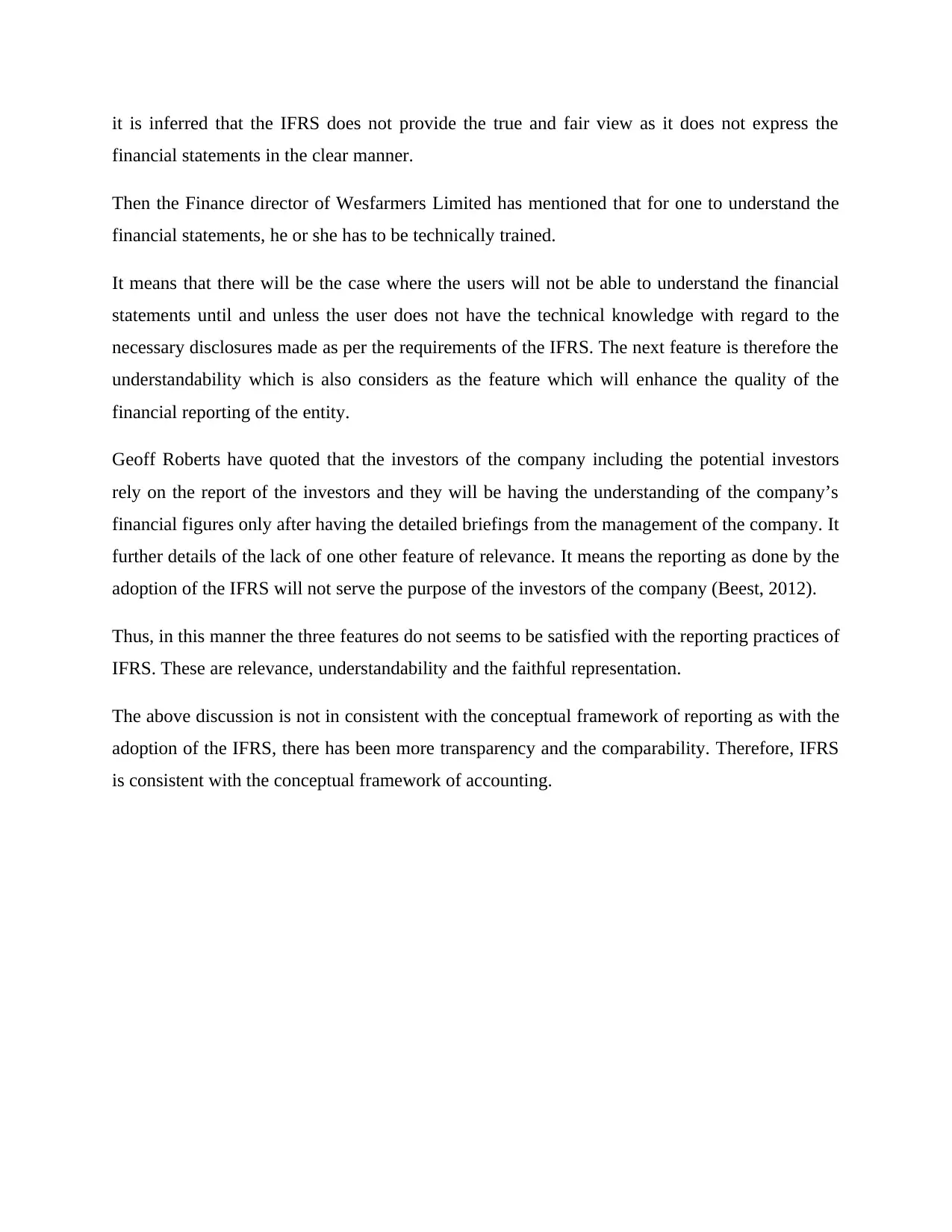
it is inferred that the IFRS does not provide the true and fair view as it does not express the
financial statements in the clear manner.
Then the Finance director of Wesfarmers Limited has mentioned that for one to understand the
financial statements, he or she has to be technically trained.
It means that there will be the case where the users will not be able to understand the financial
statements until and unless the user does not have the technical knowledge with regard to the
necessary disclosures made as per the requirements of the IFRS. The next feature is therefore the
understandability which is also considers as the feature which will enhance the quality of the
financial reporting of the entity.
Geoff Roberts have quoted that the investors of the company including the potential investors
rely on the report of the investors and they will be having the understanding of the company’s
financial figures only after having the detailed briefings from the management of the company. It
further details of the lack of one other feature of relevance. It means the reporting as done by the
adoption of the IFRS will not serve the purpose of the investors of the company (Beest, 2012).
Thus, in this manner the three features do not seems to be satisfied with the reporting practices of
IFRS. These are relevance, understandability and the faithful representation.
The above discussion is not in consistent with the conceptual framework of reporting as with the
adoption of the IFRS, there has been more transparency and the comparability. Therefore, IFRS
is consistent with the conceptual framework of accounting.
financial statements in the clear manner.
Then the Finance director of Wesfarmers Limited has mentioned that for one to understand the
financial statements, he or she has to be technically trained.
It means that there will be the case where the users will not be able to understand the financial
statements until and unless the user does not have the technical knowledge with regard to the
necessary disclosures made as per the requirements of the IFRS. The next feature is therefore the
understandability which is also considers as the feature which will enhance the quality of the
financial reporting of the entity.
Geoff Roberts have quoted that the investors of the company including the potential investors
rely on the report of the investors and they will be having the understanding of the company’s
financial figures only after having the detailed briefings from the management of the company. It
further details of the lack of one other feature of relevance. It means the reporting as done by the
adoption of the IFRS will not serve the purpose of the investors of the company (Beest, 2012).
Thus, in this manner the three features do not seems to be satisfied with the reporting practices of
IFRS. These are relevance, understandability and the faithful representation.
The above discussion is not in consistent with the conceptual framework of reporting as with the
adoption of the IFRS, there has been more transparency and the comparability. Therefore, IFRS
is consistent with the conceptual framework of accounting.
Paraphrase This Document
Need a fresh take? Get an instant paraphrase of this document with our AI Paraphraser
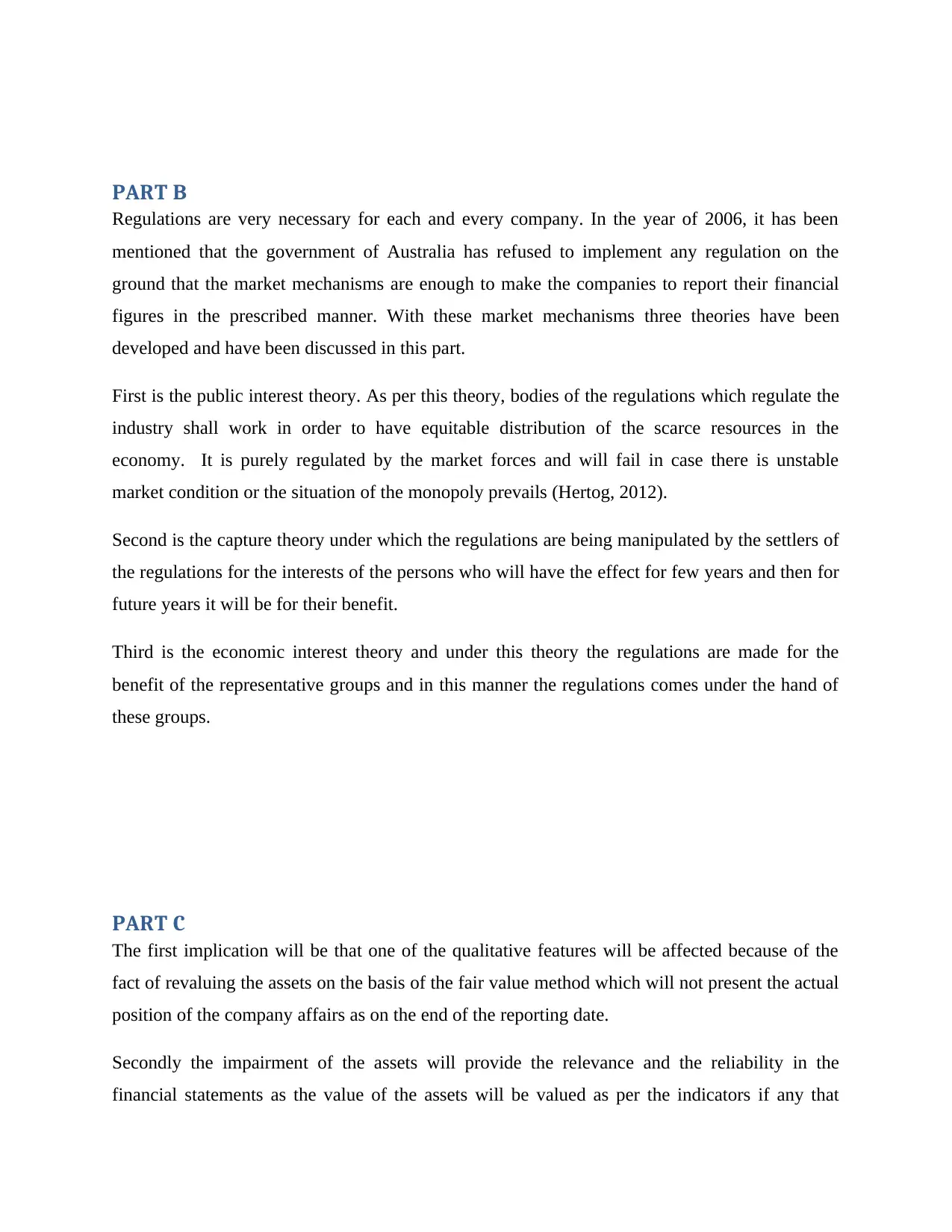
PART B
Regulations are very necessary for each and every company. In the year of 2006, it has been
mentioned that the government of Australia has refused to implement any regulation on the
ground that the market mechanisms are enough to make the companies to report their financial
figures in the prescribed manner. With these market mechanisms three theories have been
developed and have been discussed in this part.
First is the public interest theory. As per this theory, bodies of the regulations which regulate the
industry shall work in order to have equitable distribution of the scarce resources in the
economy. It is purely regulated by the market forces and will fail in case there is unstable
market condition or the situation of the monopoly prevails (Hertog, 2012).
Second is the capture theory under which the regulations are being manipulated by the settlers of
the regulations for the interests of the persons who will have the effect for few years and then for
future years it will be for their benefit.
Third is the economic interest theory and under this theory the regulations are made for the
benefit of the representative groups and in this manner the regulations comes under the hand of
these groups.
PART C
The first implication will be that one of the qualitative features will be affected because of the
fact of revaluing the assets on the basis of the fair value method which will not present the actual
position of the company affairs as on the end of the reporting date.
Secondly the impairment of the assets will provide the relevance and the reliability in the
financial statements as the value of the assets will be valued as per the indicators if any that
Regulations are very necessary for each and every company. In the year of 2006, it has been
mentioned that the government of Australia has refused to implement any regulation on the
ground that the market mechanisms are enough to make the companies to report their financial
figures in the prescribed manner. With these market mechanisms three theories have been
developed and have been discussed in this part.
First is the public interest theory. As per this theory, bodies of the regulations which regulate the
industry shall work in order to have equitable distribution of the scarce resources in the
economy. It is purely regulated by the market forces and will fail in case there is unstable
market condition or the situation of the monopoly prevails (Hertog, 2012).
Second is the capture theory under which the regulations are being manipulated by the settlers of
the regulations for the interests of the persons who will have the effect for few years and then for
future years it will be for their benefit.
Third is the economic interest theory and under this theory the regulations are made for the
benefit of the representative groups and in this manner the regulations comes under the hand of
these groups.
PART C
The first implication will be that one of the qualitative features will be affected because of the
fact of revaluing the assets on the basis of the fair value method which will not present the actual
position of the company affairs as on the end of the reporting date.
Secondly the impairment of the assets will provide the relevance and the reliability in the
financial statements as the value of the assets will be valued as per the indicators if any that
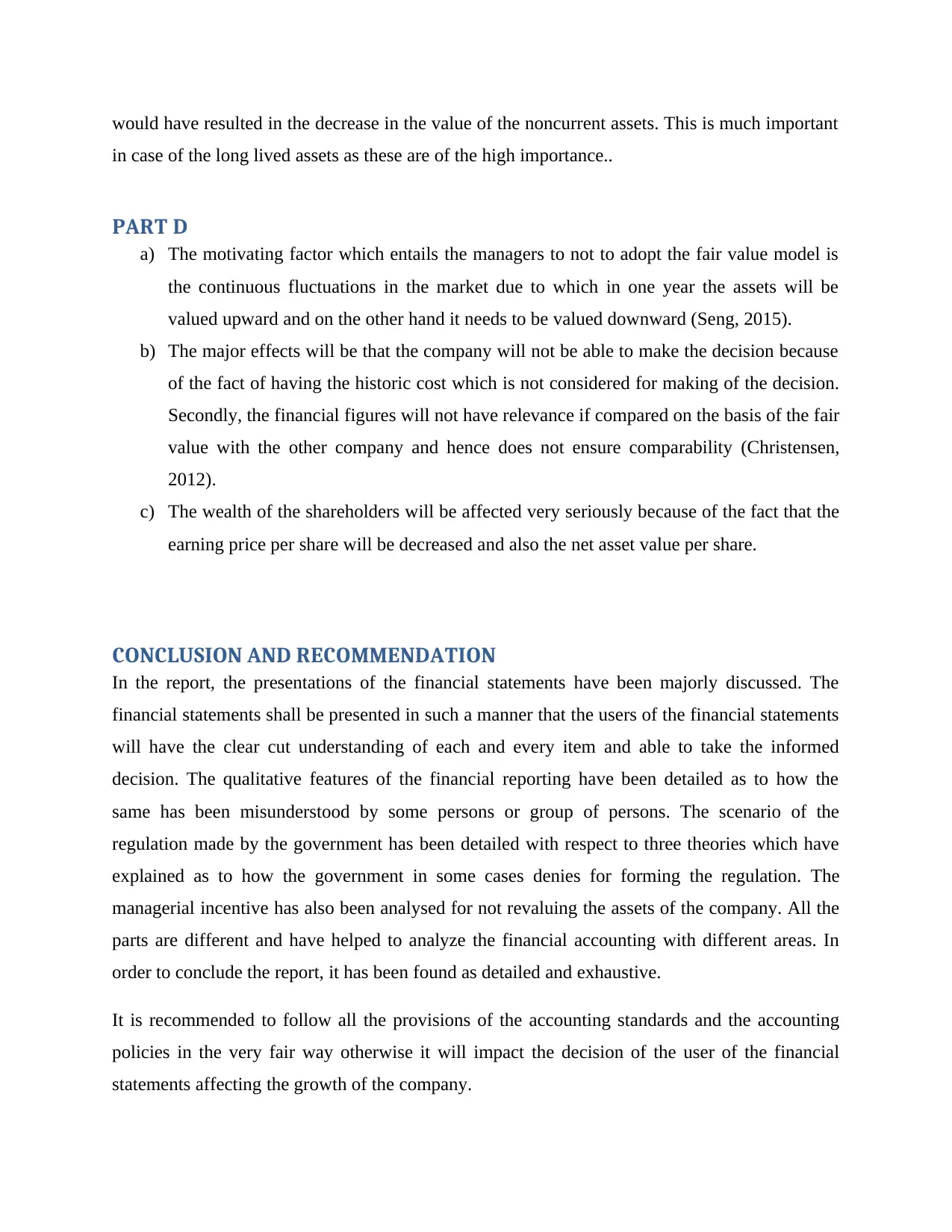
would have resulted in the decrease in the value of the noncurrent assets. This is much important
in case of the long lived assets as these are of the high importance..
PART D
a) The motivating factor which entails the managers to not to adopt the fair value model is
the continuous fluctuations in the market due to which in one year the assets will be
valued upward and on the other hand it needs to be valued downward (Seng, 2015).
b) The major effects will be that the company will not be able to make the decision because
of the fact of having the historic cost which is not considered for making of the decision.
Secondly, the financial figures will not have relevance if compared on the basis of the fair
value with the other company and hence does not ensure comparability (Christensen,
2012).
c) The wealth of the shareholders will be affected very seriously because of the fact that the
earning price per share will be decreased and also the net asset value per share.
CONCLUSION AND RECOMMENDATION
In the report, the presentations of the financial statements have been majorly discussed. The
financial statements shall be presented in such a manner that the users of the financial statements
will have the clear cut understanding of each and every item and able to take the informed
decision. The qualitative features of the financial reporting have been detailed as to how the
same has been misunderstood by some persons or group of persons. The scenario of the
regulation made by the government has been detailed with respect to three theories which have
explained as to how the government in some cases denies for forming the regulation. The
managerial incentive has also been analysed for not revaluing the assets of the company. All the
parts are different and have helped to analyze the financial accounting with different areas. In
order to conclude the report, it has been found as detailed and exhaustive.
It is recommended to follow all the provisions of the accounting standards and the accounting
policies in the very fair way otherwise it will impact the decision of the user of the financial
statements affecting the growth of the company.
in case of the long lived assets as these are of the high importance..
PART D
a) The motivating factor which entails the managers to not to adopt the fair value model is
the continuous fluctuations in the market due to which in one year the assets will be
valued upward and on the other hand it needs to be valued downward (Seng, 2015).
b) The major effects will be that the company will not be able to make the decision because
of the fact of having the historic cost which is not considered for making of the decision.
Secondly, the financial figures will not have relevance if compared on the basis of the fair
value with the other company and hence does not ensure comparability (Christensen,
2012).
c) The wealth of the shareholders will be affected very seriously because of the fact that the
earning price per share will be decreased and also the net asset value per share.
CONCLUSION AND RECOMMENDATION
In the report, the presentations of the financial statements have been majorly discussed. The
financial statements shall be presented in such a manner that the users of the financial statements
will have the clear cut understanding of each and every item and able to take the informed
decision. The qualitative features of the financial reporting have been detailed as to how the
same has been misunderstood by some persons or group of persons. The scenario of the
regulation made by the government has been detailed with respect to three theories which have
explained as to how the government in some cases denies for forming the regulation. The
managerial incentive has also been analysed for not revaluing the assets of the company. All the
parts are different and have helped to analyze the financial accounting with different areas. In
order to conclude the report, it has been found as detailed and exhaustive.
It is recommended to follow all the provisions of the accounting standards and the accounting
policies in the very fair way otherwise it will impact the decision of the user of the financial
statements affecting the growth of the company.
⊘ This is a preview!⊘
Do you want full access?
Subscribe today to unlock all pages.

Trusted by 1+ million students worldwide
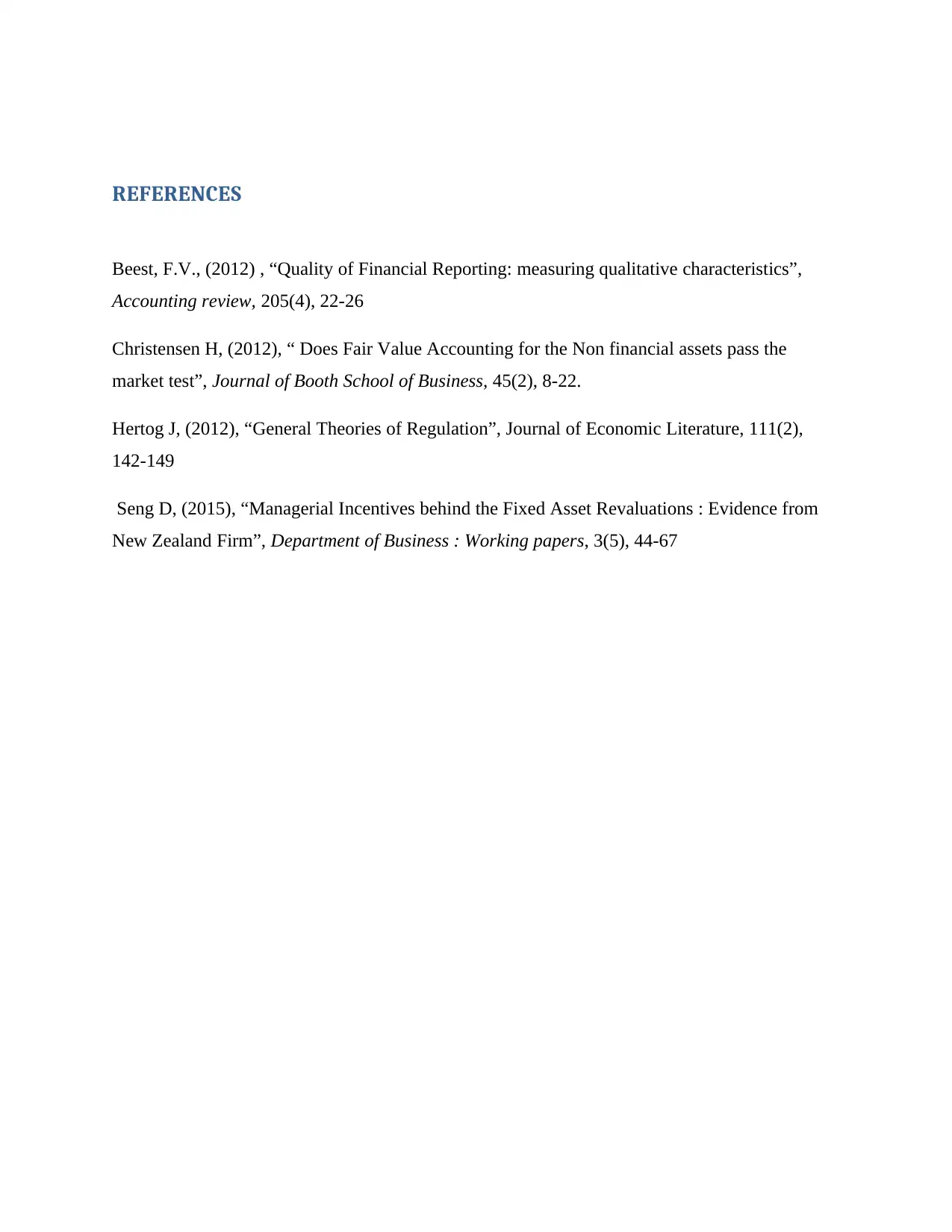
REFERENCES
Beest, F.V., (2012) , “Quality of Financial Reporting: measuring qualitative characteristics”,
Accounting review, 205(4), 22-26
Christensen H, (2012), “ Does Fair Value Accounting for the Non financial assets pass the
market test”, Journal of Booth School of Business, 45(2), 8-22.
Hertog J, (2012), “General Theories of Regulation”, Journal of Economic Literature, 111(2),
142-149
Seng D, (2015), “Managerial Incentives behind the Fixed Asset Revaluations : Evidence from
New Zealand Firm”, Department of Business : Working papers, 3(5), 44-67
Beest, F.V., (2012) , “Quality of Financial Reporting: measuring qualitative characteristics”,
Accounting review, 205(4), 22-26
Christensen H, (2012), “ Does Fair Value Accounting for the Non financial assets pass the
market test”, Journal of Booth School of Business, 45(2), 8-22.
Hertog J, (2012), “General Theories of Regulation”, Journal of Economic Literature, 111(2),
142-149
Seng D, (2015), “Managerial Incentives behind the Fixed Asset Revaluations : Evidence from
New Zealand Firm”, Department of Business : Working papers, 3(5), 44-67
1 out of 7
Related Documents
Your All-in-One AI-Powered Toolkit for Academic Success.
+13062052269
info@desklib.com
Available 24*7 on WhatsApp / Email
![[object Object]](/_next/static/media/star-bottom.7253800d.svg)
Unlock your academic potential
Copyright © 2020–2025 A2Z Services. All Rights Reserved. Developed and managed by ZUCOL.




